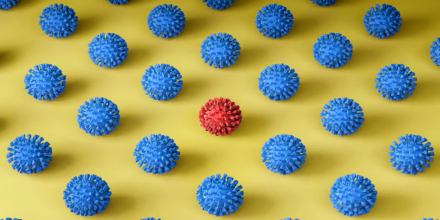Beyond the spotlight on spike proteins
22.09.2023 posted by Admin

The spotlight during the COVID-19 pandemic has primarily focused on the spike protein found on the surface of the SARS-CoV-2 virus, the culprit behind the disease. Understandably so, because this spike protein is what allows the virus to infiltrate human cells.
However, it's important to recognize that the spike protein is just one piece of the puzzle that makes SARS-CoV-2 a formidable adversary. Scientists from the University of California, San Francisco's Quantitative Biosciences Institute (QBI), Icahn School of Medicine at Mount Sinai, and University College London have recently published an article in Cell (available online since September 21) that delves into this aspect. Their discoveries shed light on the virus's ongoing evolution and support the idea of using a combination of therapies to target the proteins that aid the virus in suppressing our immune system, according to Dr. Nevan Krogan, the lead researcher and founder of QBI, in a conversation with Fierce Biotech Research.
Dr. Krogan explained, "We've deciphered how this virus will continue to adapt, at least to a significant extent. Similar to how we approach HIV, we need a mixture of treatments."
These latest findings build upon more than 50 studies conducted by the QBI Coronavirus Research Group during the pandemic. This network of scientists, established by Dr. Krogan, has been monitoring the evolution of COVID-19 and identifying potential therapies since the virus first emerged in 2020. In addition to numerous research papers, this collaboration has also led to two clinical trials, including one with the Spanish pharmaceutical company PharmaMar, exploring the use of the cancer drug plitidepsin as a treatment for COVID-19 in immunocompromised patients.
Dr. Krogan emphasized, "We now possess a profound understanding of how this virus functions."
This understanding includes an explanation for the convergent evolution of various virus strains, meaning they mutate via different pathways but ultimately lead to the same outcome: suppression of the body's innate immune response.
Dr. Krogan elaborated, "These strains seem to be converging on a similar final result, although they take distinct evolutionary paths with different mutations. It's almost as if, when you try to push it in one direction, it will find another way to achieve its goals."
To illustrate this, the researchers conducted experiments with healthy lung cells, exposing them to different strains of the virus, ranging from alpha to omicron BA.1. They then used computational tools to analyze changes in protein and gene expression among these strains and their effects on the host cells' genes.
While the virus's strategies for evading the immune system varied depending on the strain, they shared a common mechanism involving a select group of proteins. Among these proteins, ORF9b stood out as a significant contributor to enabling pre-omicron variants of the virus to suppress the innate immune response—the body's initial defense mechanism against pathogens—and infiltrate host cells.
However, it's important to recognize that the spike protein is just one piece of the puzzle that makes SARS-CoV-2 a formidable adversary. Scientists from the University of California, San Francisco's Quantitative Biosciences Institute (QBI), Icahn School of Medicine at Mount Sinai, and University College London have recently published an article in Cell (available online since September 21) that delves into this aspect. Their discoveries shed light on the virus's ongoing evolution and support the idea of using a combination of therapies to target the proteins that aid the virus in suppressing our immune system, according to Dr. Nevan Krogan, the lead researcher and founder of QBI, in a conversation with Fierce Biotech Research.
Dr. Krogan explained, "We've deciphered how this virus will continue to adapt, at least to a significant extent. Similar to how we approach HIV, we need a mixture of treatments."
These latest findings build upon more than 50 studies conducted by the QBI Coronavirus Research Group during the pandemic. This network of scientists, established by Dr. Krogan, has been monitoring the evolution of COVID-19 and identifying potential therapies since the virus first emerged in 2020. In addition to numerous research papers, this collaboration has also led to two clinical trials, including one with the Spanish pharmaceutical company PharmaMar, exploring the use of the cancer drug plitidepsin as a treatment for COVID-19 in immunocompromised patients.
Dr. Krogan emphasized, "We now possess a profound understanding of how this virus functions."
This understanding includes an explanation for the convergent evolution of various virus strains, meaning they mutate via different pathways but ultimately lead to the same outcome: suppression of the body's innate immune response.
Dr. Krogan elaborated, "These strains seem to be converging on a similar final result, although they take distinct evolutionary paths with different mutations. It's almost as if, when you try to push it in one direction, it will find another way to achieve its goals."
To illustrate this, the researchers conducted experiments with healthy lung cells, exposing them to different strains of the virus, ranging from alpha to omicron BA.1. They then used computational tools to analyze changes in protein and gene expression among these strains and their effects on the host cells' genes.
While the virus's strategies for evading the immune system varied depending on the strain, they shared a common mechanism involving a select group of proteins. Among these proteins, ORF9b stood out as a significant contributor to enabling pre-omicron variants of the virus to suppress the innate immune response—the body's initial defense mechanism against pathogens—and infiltrate host cells.